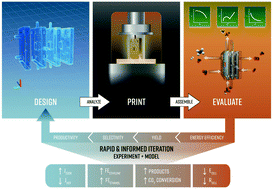Advanced manufacturing for electrosynthesis of fuels and chemicals from CO2†
Abstract
Advanced manufacturing (AM) represents an appealing approach for creating novel electrochemical systems for chemicals synthesis. In this work, we demonstrate AM for rapid development and testing for improved performance for the carbon dioxide reduction reaction across an evolution of vapor-fed reactor designs. In our final design, we observe activation- and mixed-control regimes for a variety of operating conditions via inlet CO2 flow rate and electrochemical potential. Furthermore, we define a dimensionless number (Da) to identify mass transport regimes by exploring the impact of hypothesized underlying mass transport mechanisms, including consumption of CO2via OH−, increased local temperatures, and partial penetration of electrolyte into gas diffusion layer. The accelerated pace of reactor design and development led to high geometric current densities (500 mA cm−2), heightened selectivity (85.5% FE C2+ products), and increased carbon dioxide conversion (16.6%) and cathodic energy efficiency (49.6% CO2R). Using AM vapor-fed reactors, we attain high ethylene (3.67%) and record ethanol (3.66%) yields compared to the literature. This work underscores the promise of AM for accelerating reactor design, understanding of governing phenomena, and improving the performance of catalytic systems.



 Please wait while we load your content...
Please wait while we load your content...